What is the selectivity of protection in electrical installations
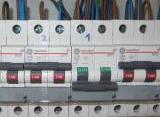 When operating and designing an electrical circuit, attention is always paid to issues of its safe use. For this purpose, all electrical devices are protected with special devices that are selected and placed strictly according to a certain hierarchical relationship.
When operating and designing an electrical circuit, attention is always paid to issues of its safe use. For this purpose, all electrical devices are protected with special devices that are selected and placed strictly according to a certain hierarchical relationship.
For example, when a mobile phone is charging, its flow is controlled by the protection built into the battery. It cuts off the charging current at the end of the capacity build-up. When a short circuit occurs inside the battery, the fuse installed in the charger blows and disconnects the circuit.
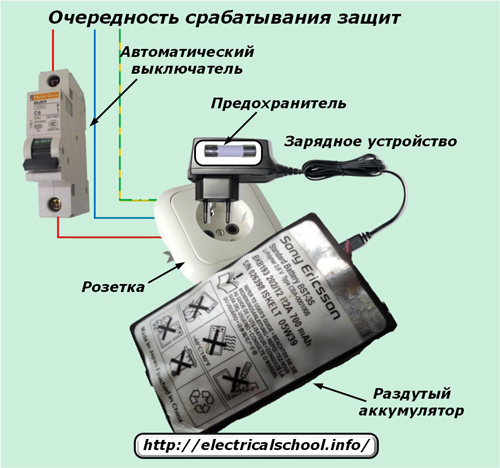
If for some reason this does not happen, then the fault in the outlet is controlled by the circuit breaker on the apartment panel, and its operation is insured by the main machine. This sequence of alternative actions of defenses can be considered further.
Its models are determined by the principle of selectivity, which is also called selectivity, emphasizing the function of selecting or determining the location of the fault to be disabled.
Types of selectivity
Electrical protection selectivity methods are formed during the creation of the project and are maintained during operation in such a way as to promptly identify the place of occurrence of a malfunction in electrical equipment and separate it from the working circuit with the smallest losses for it.
In this case, the protection coverage area is divided according to selectivity into:
1. absolute;
2. relative.
The first type of protection completely controls the working area and repairs damage only in it. Built-in electrical appliances work on this model. circuit breakers.
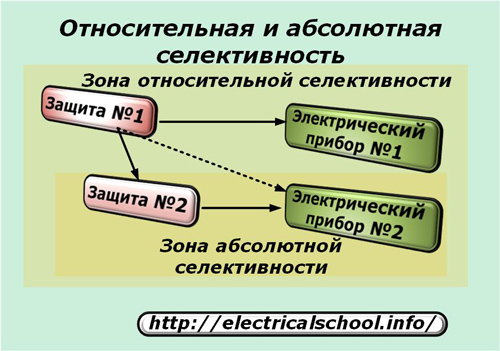
Devices built on a relative basis perform more functions. They exclude faults in their zone and neighboring ones, but when absolute type protections have not worked in them.
Well-tuned protection defines:
1. location and type of damage;
2. the difference between an abnormal but permissible mode from a situation that can cause very serious damage to the equipment of an electrical installation in the controlled area.
Devices configured only in the first action usually work on non-critical networks up to 1000 volts. For high voltage electrical installations try to apply both principles. To this end, the following are included in the protection:
-
blocking schemes;
-
precision measuring devices;
-
information exchange systems;
-
special logic algorithms.
Protection against overcurrent exceeding the rated load for any reason is provided between two circuit breakers connected in series.In this case, the switch closest to the user with a fault must turn off the fault by opening its contacts, and the remote one must continue to supply voltage to its section.
In this case, two types of selectivity are considered:
1. completed;
2. partial.
If the protection closest to the fault is able to completely eliminate the fault in the entire setting range without triggering the remote switch, then it is considered complete.
Partial selectivity is inherent in short-distance protections configured to operate up to some limiting selectivity Is. If it is exceeded, then the remote switch comes into action.
Overload and short circuit zones in selective protections
Current limits specified for operation automatic safety switches, are divided into two groups:
1. overload mode;
2. short circuit area.
For ease of explanation, this principle applies to the current characteristics of circuit breakers.
They are set to work in the overload zone with rated currents up to 8 ÷ 10 times.
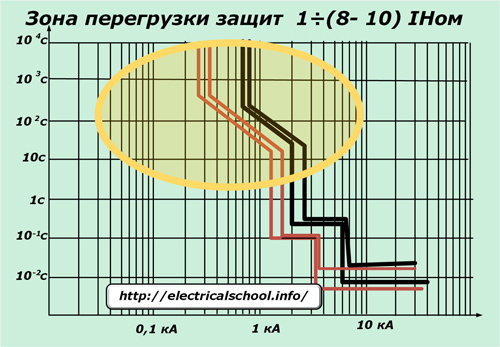
In this area, thermal or thermomagnetic protective releases mainly work. Short-circuit currents very rarely fall into this zone.
The short-circuit occurrence zone is usually accompanied by currents that exceed the rated load of the breakers by 8 ÷ 10 times and are characterized by serious damage to the electrical circuit.
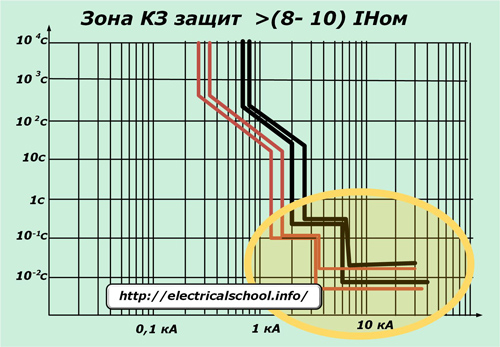
To turn them off, electromagnetic or electronic releases are used.
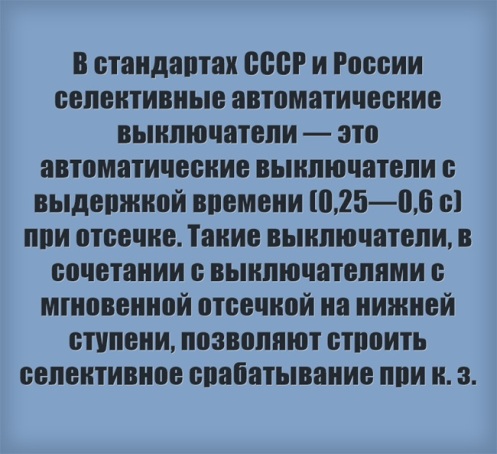
Methods for creating selectivity
For the overcurrent range, protections are created that work on the principle of time current selectivity.
The short-circuit zone is formed based on:
1. current;
2. temporary;
3. energy;
4. area selectivity.
Time selectivity is created by choosing different time delays for the protective operation. This method can be applied even to devices with the same current setting but different timing as shown in the figure.
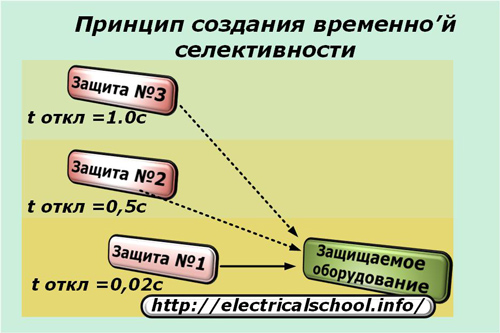
For example, protection No. 1 closest to the equipment is set to operate in the event of a short circuit with a time close to 0.02 s, and its operation is provided by the more distant No. 2 with a setting of 0.5 s.
The farthest protection with a shutdown time of one second supports the operation of the previous devices in the event of a possible failure.
Current selectivity regulated for operation when the permissible loads are exceeded. Roughly this principle can be explained with the following example.
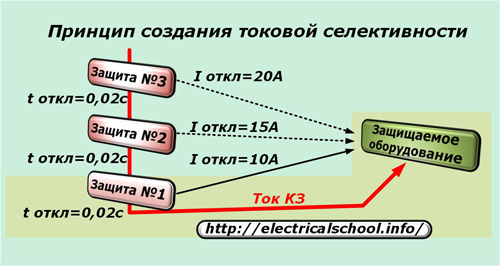
Three protections in series monitor the short-circuit current and are configured to operate with a time of 0.02 s, but with different current settings of 10, 15 and 20 amps. Therefore, the equipment will first be disconnected from the protective device No. 1, and No. 2 and No. 3 will selectively insure it.
Realizing time or current selectivity in its purest form requires the use of sensitive current and time sensors or relays. In this case, a rather complex electrical circuit is created, which in practice usually combines both of the considered principles and is not applied in its pure form.
Selectivity of time current protection
To protect electrical installations with a voltage of up to 1000 volts, automatic switches are used, which have a combined time-current characteristic.Let us examine this principle using the example of two series-connected machines located at the ends of the line on the load and supply side.
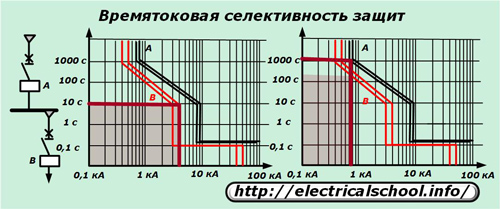
Time selectivity determines how the circuit breaker is set to trip when it is near the consumer rather than at the end of the generator.
The left graph shows the case of the longest tripping time of the upper protection curve on the load side, and the right one shows the shortest time of the circuit breaker at the supply end. This allows a more detailed analysis of the manifestation of the selectivity of the protections.
Switch «B» located closer to the supplied equipment, due to the use of time current selectivity, works earlier and faster, and switch «A» retains it in case of failure.
Current selectivity of protection
In this method, the selectivity can be formed by creating a certain network configuration, for example included in the circuit of a cable or overhead power line, which has an electrical resistance. In this case, the value of the short-circuit current between the generator and the consumer depends on the location of the fault.
At the power end of the cable it will have a maximum value of say 3 kA and at the opposite end a minimum value of say 1 kA.
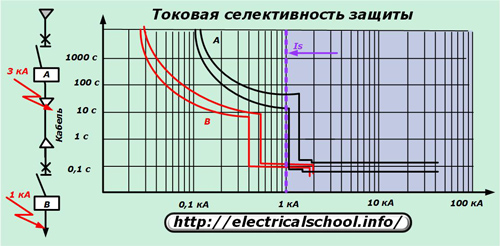
In case of a short circuit near the switch A, the protection of the end B (I kz1kA) should not work, then it should remove the voltage from the equipment. For the correct operation of the protections, it is necessary to take into account the magnitude of the real currents passing through the switches in emergency mode.
It should be understood that in order to ensure full selectivity with this method, it is necessary to have a large resistance between the two switches, which can be formed due to:
-
extended power line;
-
transformer winding placement;
-
inclusion in the break of the cable with a reduced cross-section or in other ways.
Therefore, with this method, the selectivity is often partial.
Time selectivity of protection
This method of selectivity usually complements the previous method, taking into account the times:
-
determination by the protection of the place and the beginning of the development of the fault;
-
trigger on shutdown.
The formation of the algorithm of the protective operation is carried out due to the gradual convergence of the current settings and the time when the short-circuit currents move to the power source.
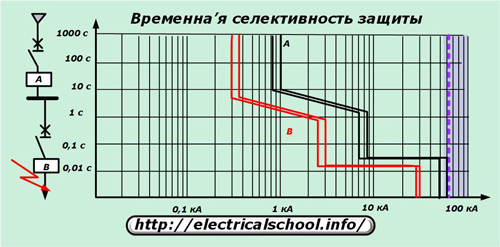
Time selectivity can be created by machines with the same current ratings when they have the ability to adjust the response delay.
With this method of protecting switch B, the fault is turned off, and switch A — they control the whole process and are ready for operation. If during the time allotted for the operation of the protections B, the short circuit is not eliminated, the fault is eliminated by the action of the protections on the A side.
Energy selectivity of protections
The method is based on the use of special new types of circuit breakers, made in a molded case and capable of operating as quickly as possible when the short-circuit currents have not even had time to reach their maximum values.
Rate automata of this kind operate for a few milliseconds while the transient aperiodic components are still active.Under such conditions, due to the high dynamics of the flow of loads, it is difficult to coordinate the actually operating time-current characteristics of the protections.
The end user has little or no trace of the energy selectivity characteristics. They are provided by the manufacturer in the form of graphs, calculation programs, tables.
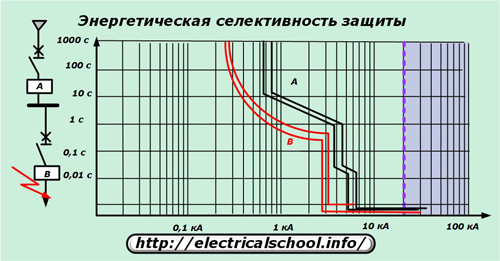
This method must take into account the specific operating conditions for thermomagnetic and electronic releases on the supply side.
Zone selectivity of the defense
This type of selectivity is a type of temporal characteristic. For its operation, current measuring devices are used on each side, between which information is constantly exchanged and current vectors are compared.
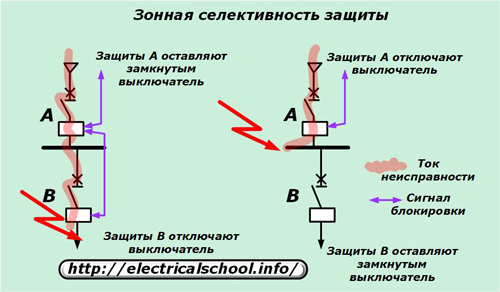
Zone selectivity can be formed in two ways:
1. Signals from both ends of the monitored area are sent to the logic protection monitoring device at the same time. It compares the values of the input currents and determines the breaker to open;
2. the information about the overestimated values of the current vectors on both sides comes in the form of a blocking signal to the logic part of the protection at a higher level of hierarchy on the power supply side. If there is a blocking signal underneath, then the downstream switch is off. When the bottom trip prohibition is not received, the voltage is removed from the top protection.
With these methods, shutdown is much faster than with time selectivity. This guarantees less damage to electrical equipment, lower dynamic and thermal loads in the system.
However, the selectivity zoning method requires the creation of additional complex technical systems for measurement, logic and information exchange, which increases the cost of the equipment. For these reasons, these high-frequency blocking techniques are used in transmission lines and high-voltage substations that transmit continuously large power flows.
High speed air, oil or SF6 circuit breakers capable of switching huge current loads are used for this purpose.
